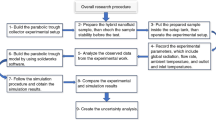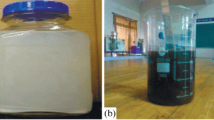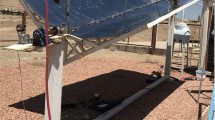Abstract
The present work analyzes the performance of unshielded receiver tube integrated solar parabolic trough collector where Al2O3/deionized (DI) water nanofluid of low concentrations was used as heat transfer fluid (HTF) element. Nanofluid is synthesized at various volume fractions starting from 0.2 to 1.0% with surfactant-free condition, by ultrasonic technique. Several researchers investigated the performance of higher nanofluid concentrations (1.0–5.0%) with and without surfactants on parabolic trough solar collector. The outdoor experiments are conducted for two HTF flow rates of 0.010 kg s−1 and 0.015 kg s−1. When the nanofluid is subjected as HTF, the DI water acted as a base fluid. While DI water is allowed to flow through the absorber, it performs both as HTF and heat storage fluid. The synthesized nanofluid at various volume fractions is allowed to flow through the receiver for the purpose of analyzing the thermal performance and compare the results with DI water. The collector efficiency increases with the mass flow rate as well as the concentration of nanofluid. For 0.015 kg s−1, the maximum efficiency was calculated as 59.13% (hourly) and 58.68% (average).














Similar content being viewed by others
Abbreviations
- A :
-
Area (m2)
- CR:
-
Concentration ratio (−)
- DI:
-
Deionized (−)
- D :
-
Diameter (−)
- F, R :
-
Factor (−)
- HTF:
-
Heat transfer fluid (−)
- I :
-
Radiation (W m−2)
- K :
-
Thermal conductivity (W m−1 K−1)
- K(θ):
-
Incident angle modifier
- L :
-
Aperture length (m)
- m :
-
Mass (g)
- Nu:
-
Nusselt number (−)
- Pr:
-
Prandtl number (−)
- Q :
-
Heat gain (W)
- Re:
-
Reynolds number (−)
- S :
-
Solar flux (W m−2)
- SPTC:
-
Solar parabolic trough collector (−)
- T :
-
Temperature (°C)
- U, h :
-
Coefficient (W m−2 K−1)
- USR:
-
Unshielded receiver (−)
- V :
-
Volume (m3)
- W :
-
Aperture width (m)
- a :
-
Aperture, ambient
- b :
-
Beam, tilt
- bf:
-
Base fluid
- fi:
-
Nanofluid inlet, inside heat transfer
- fo:
-
Nanofluid outlet
- i :
-
Inner
- ins:
-
Instantaneous
- l :
-
Heat loss
- np:
-
Nanoparticle
- opt:
-
Optical
- r :
-
Radiation loss
- R :
-
Heat removal
- Ω :
-
Hour angle
- ɸ :
-
Volume fraction
- η :
-
Efficiency
- ῤ :
-
Reflectivity
- u :
-
Useful
- w :
-
Wind loss
- θ :
-
Incident angle
- τ :
-
Transmittance
- α :
-
Absorptance
- ϒ :
-
Intercept factor
- σ :
-
Stefan–Boltzmann constant
- εr :
-
Emissivity
References
Kalogirou SA, Lloyd S. Use of solar parabolic trough collectors for hot water production in Cyprus—a feasibility study. Renew Energy. 1992;12:117–24.
Nithyanandam K, Pitchumani R. Optimization of an encapsulated phase change material Thermal energy storage system. Sol Energy. 2014;107:770–88.
Sheikholeslami M, Jafaryar M, Shafee A, Babazzadeh H. Acceleration of discharge process of clean energy storage unit with insertion of porous form considering nanoparticle enhanced paraffin. J Clean Prod. 2020;261:121206.
Vijayan G, Karunakaran R. Investigation of heat transfer performance of nanofluids on conical solar collector under dynamic condition. Adv Mater Res. 2014;985:1125–31.
Vijayan G, Karunakaran R. Experimental investigation on PTSC hot water generation system. J Adv Chem. 2017;13:6054–8.
Valanarasu A, Sornakumar SM. Theoretical analysis and experimental verification of parabolic trough solar collector with hot water generation system. Therm Sci. 2007;11(1):119–26.
Valanarasu A, Sornakumar SM. Performance characteristics of the solar parabolic trough collector with hot water generation system. Therm Sci. 2006;10(2):167–74.
Bellos E, Tzivanidis C, Antonopoulos KA. A detailed working fluid investigation for solar parabolic trough collectors. Appl Therm Eng. 2016;114:374–86.
Bellos E, Tzivanidis C. Thermal efficiency enhancement of nanofluid-based parabolic trough collectors. J Therm Anal Calorim. 2019;135(1):597–608.
Bellos E, Tzivanidis C. A review of concentrating solar thermal collectors with and without nanofluids. J Therm Anal Calorim. 2019;135(1):763–86.
Vijayan G, Karunakaran R. Characteristic analysis of de-ionised water and ethylene glycol based aluminum oxide nanofluid. J Adv Chem. 2017;13(5):6202–7.
Murshed SMS, Leong KC, Yang C. Investigations of thermal conductivity and viscosity of nanofluids. Int J Therm Sci. 2008;47:560–8.
Sadaghiyani OM, Sadegi A, Khalileria S, Mirzaee I. Two new designs of parabolic solar collectors. Therm Sci. 2014;18(2):323–34.
Stefanovic VP, Bojic M. Development and investigation of solar collectors for conversion of solar radiation into heat and/or electricity. Therm Sci. 2006;10(4):177–87.
Marco P, Marco M, Gianpiero C, Arturo DR. Experimental investigation of transparent parabolic trough collector based on gas-phase nanofluid. Appl Energy. 2017;203(1):560–70.
Visconti P, Primiceri P, Costantini P, Cavalera G. Measurement and control system for thermosolar plant and performance comparison between traditional and nanofluid solar thermal collectors. Int J Smart Sens Intell Syst. 2016;9(3):681–708.
Colangelo G, Milanese M, Risi AD. Numerical simulation of thermal efficiency of an innovative Al2O3 nanofluid solar thermal collector: influence of nanoparticles concentration. Therm Sci. 2017;21(6B):2769–79.
Ghasemi SE, Ranjbar AA. Effect of nanoparticles in working fluid on thermal performance of solar parabolic trough collector. J Mol Liq. 2016;222:159–66.
Subramani J, Nagarajan PK, Wongwises S, El-Agouz SA, Sathyamurthy R. Experimental study on the thermal performance and heat transfer characteristics of solar parabolic trough collector using Al2O3 nanofluids. Environ Prog Sustain Energy. 2018;37:1149–59.
Khan MS, Abid M, Ratlamwala TAH. Energy, exergy and economic feasibility analyses of a 60 MW conventional steam power plant integrated with parabolic trough solar collectors using nanofluids. Iran J Sci Technol Trans Mech Eng 2017;1–17.
Thomas A. Simple structure for parabolic trough concentrator. Energy Convers Manag. 1994;35:569–73.
Kalogirou SA. Parabolic trough collector system for low-temperature steam generation: design and performance characteristics. Appl Energy. 1996;55:1–19.
Kumaresan G, Rahulram S, Velraj R. Performance studies of a solar parabolic trough collector with a thermal energy storage system. Energy. 2012;47:395–402.
Vijayan G, Karunakaran R. Performance evaluation of nanofluid on parabolic trough solar collector. Therm Sci. 2020;24(2A):853–64.
Senthil R, Cheralathan M. Effect of non-uniform temperature distribution on surface absorption receiver in parabolic dish solar concentrator. Therm Sci. 2017;21(4):2011–9.
Senthil R, Cheralathan M. Enhancement of the thermal energy storage capacity of a parabolic dish concentrated solar receiver using phase change materials. J Energy Storage. 2019;25:100841.
Farshad SA, Sheikholeslami M. Nanofluid flow inside a solar collector utilizing twisted tape considering exergy and entropy analysis. Renew Energy. 2019;141:246–58.
Duffie JA, Beckman WA. Solar engineering of thermal processes. New York: John Wiley and Sons; 1991.
Brooks MJ, Mills I, Harms TM. Performance of a parabolic trough solar collector. J Energy South Afr. 2006;17(3):71–80.
Filonienko GK. Friction factor for turbulent pipe flow. Teploenergetika. 1954;1(4):40–4.
Gnielinski V. New equations for heat and mass transfer in the turbulent pipe and channel flow. Int J Chem Eng. 1976;16:359–68.
Kline S, McClintock F. Describing uncertainties in single-sample experiments. Mech Eng. 1953;75:3–8.
Moffat RJ. Describing the uncertainties in experimental results. Exp Therm Fluid Sci. 1988;1:3–17.
Senthil R. Thermal performance of aluminum oxide based nanofluids in flat plate solar collector. Int J Eng Adv Technol. 2019;8(3):445–8.
Khullar V, Tyagi H. Application of nanofluids as the working fluid in concentrating parabolic solar collectors. In: Proceedings of international conference on fluid mechanics and Fluid power. IIT Madras, Chennai, 2010; 1–9.
Singh H. Singh PA review paper on performance improvement of parabolic trough collector system. J Appl Mech Eng. 2015;4(2):1–10.
Rasih RA, Sidik NAC, Samion S. Recent progress on concentrating direct absorption solar collector using nanofluids: a review. J Therm Anal Calorim. 2019;137(3):903–22.
Kalogirou S. Parabolic trough collector system for low temperature steam generation: design and performance characteristics. Appl Energy. 1996;55(1):1–19.
Murphy LM., Keneth E. Steam generation in line-focus solar collectors: A comparative assessment of thermal performance, operating stability, and cost issues. In: SERI/TR-1311; 1982. https://doi.org/10.2172/5247106.
Author information
Authors and Affiliations
Corresponding author
Additional information
Publisher's Note
Springer Nature remains neutral with regard to jurisdictional claims in published maps and institutional affiliations.
Rights and permissions
About this article
Cite this article
Vijayan, G., Shantharaman, P.P., Senthil, R. et al. Thermal performance analysis of a low volume fraction Al2O3 and deionized water nanofluid on solar parabolic trough collector. J Therm Anal Calorim 147, 753–762 (2022). https://doi.org/10.1007/s10973-020-10313-w
Received:
Accepted:
Published:
Issue Date:
DOI: https://doi.org/10.1007/s10973-020-10313-w




